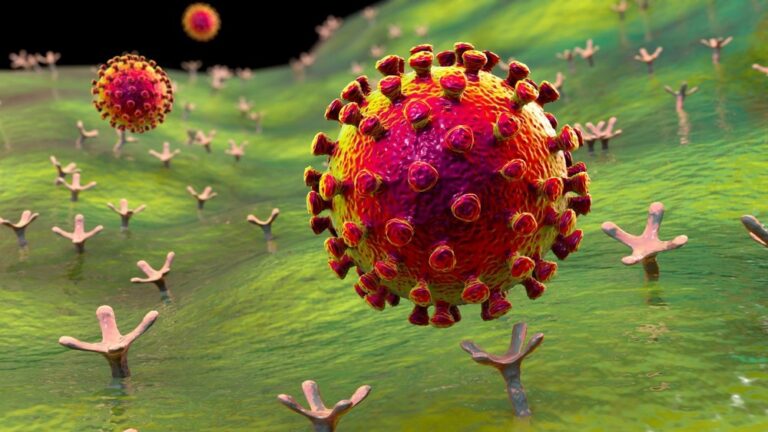
In a recent study posted to the bioRxiv* preprint server, researchers investigated the potential of the calpain-2 (CAPN2) molecule as a therapeutic goal against (severe acute respiratory syndrome coronavirus 2 (SARS-CoV-2).
Study: Calpain-2 mediates SARS-CoV-2 entry and represents a therapeutic goal. Image Credit: Kateryna Kon/Shutterstock
Background
Coronavirus disease 2019 (COVID-19) has caused considerable morbidity and mortality across the globe, warranting the event of therapeutic agents against SARS-CoV-2. The authors of the current study previously found that calpain inhibitor molecules effectively inhibited SARS-CoV-2 by targeting the Mpro (important protease) enzyme of the virus, critical for processing SARS-CoV-2 proteins.
In regards to the study
In the current study, researchers prolonged their previous evaluation by investigating caplain-2 as a probable goal for developing anti-SARS-CoV-2 agents.
The authors had recently screened for antiviral compounds using Vero E6 cells and recombinant SARS-CoV-2mNeonGreen virus, wherein several compounds demonstrated anti-SARS-CoV-2 efficacy, and the highest 18 hits were validated in the current study. For the validation experiments, recombinant vesicular stomatitis virus (VSV) e-green fluorescent protein (eGFP) reporter viruses encoding either native VSV-G or the spike (S) protein of SARS-CoV-2 were used.
To analyze whether the MG132 compound that targeted host CPN2 could inhibit SARS-CoV-2, calpain inhibitor molecules corresponding to ALLN, calpeptin, E-64d, and calpain inhibitor III were used because the molecules inhibit calpain with various specificities and goal the calpain family in a different way.
To evaluate CAPN2 involvement in COVID-19, a genetic knockout (KO) of the gene was performed using lentivirus-facilitated Cas9/CRISPR (clustered recurrently interspaced short palindrome repeats) amongst MA104 cells, that express angiotensin-converting enzyme 2 (ACE2), critical for viral entry.
Further, western blot evaluation was performed to validate CAPN2 KO efficiency. CAPN2 KO and wild-type (WT) cells were inoculated with SARS-CoV-2 S protein expressing chimeric VSV (VSV-SARS-CoV-2).
Standard plaque assays of VSV-SARS-CoV-2 infections were performed, and the time point at which CAPN2 exerted pro-viral effects was determined. KO and WT cells were inoculated with VSV-SARS-CoV-2, and the extent of viral messenger ribonucleic acid (mRNA) was determined at 1.0- to six.9 hours post-infection (hpi) by quantitative reverse-transcription-polymerase chain response (RT-qPCR).
Further, a recombinant SARS-CoV-2 strain with S mutations, D614G, E484K, and N501Y, was tested. Single-clone CAPN2 KO MA104 cells were generated and confirmed by Sanger sequencing. Moreover, classical VSV-SARS-CoV-2 cold binding assays were performed to analyze whether VSV-SARS-CoV-2 adsorption was impacted negatively by the shortage of caplain-2, and the potential S protein cleave by CAPN2 was evaluated.
Co-transfection experiments were performed using ACE2-expressing human embryonic kidney (HEK)293 cells and WA1 strain S protein, with CAPN2, furin, or TMPRSS2 (transmembrane serine protease 2), key proteases reported for cleaving the S protein for efficient host invasion. Subsequently, the team harvested the cellular lysates and quantified the intensities of whole-S protein and the cleaved product, subunit 2 (S2), followed by an assessment of ACE2 levels in CAPN2 KO and WT cells.
Results
Calpain inhibitors (calpain inhibitor III, calpeptin, E-64d, and ALLN) effectively inhibited VSV-SARS-CoV-2 with 50% inhibition effective concentration (EC50) values <1.5 µM, but not Mpro, and contrastingly, calpain inhibitors showed no antiviral activity towards the native proteins of WT VSV. VSV-SARS-CoV-2 infections were significantly lowered amongst calpain-2 KO cells, and CAPN2 was critical for an initial step within the proliferation of SARS-CoV-2. CAPN2 promoted SARS-CoV-2 binding with cells of the host.
The findings indicated that calpain inhibitor molecules targeted a Mpro-independent pathway to effectively inhibit SARS-CoV-2 and calpain-2 as a recent host factor that might be potentially targeted on the host cell invasion step to widen the therapeutic landscape of COVID-19. Most antiviral compounds tested demonstrated dose-dependent infection by VSV and VSV-SARS-CoV-2 inhibition amongst MA104 cells.
IMBX (3-isobutyl-1-methylxanthine), Nigericin, and brefeldin A showed EC50 values below 2.0 μM against infections of VSV and VSV-SARS-CoV-2. Nitazoxanide showed SARS-CoV-2 inhibition, and MG132 was 100-fold selective in activity against VSV and VSV-SARS-CoV-2 with EC50 values of 44 and 0.6 µM, respectively. No inhibitor except calpeptin showed cytotoxicity. VSV-SARS-CoV-2 mRNA was lowered by 4.0-fold in cells lacking CAPN2. VSV-SARS-CoV-2 plaques were 1.0 mm and a couple of.0mm in size in KO and WT cells, respectively. Nevertheless, there have been no significant differences in VSV plaque sizes in KO and WT cells.
GFP signals from VSV-SARS-CoV-2 were lowered amongst CAPN2 knockout cells at six hpi, indicating that CAPN2 aided the replication of SARS-CoV-2. Significantly lesser VSV-SARS-CoV-2 mRNA and S protein levels were noted in KO cells in comparison with WT cells. Of interest, non-significantly lower levels of mRNA were present in CAPN2 knockout cells, indicating that CAPN2 effects on SARS-CoV-2 probably trusted the S protein nature.
As well as, the degrees of viral mRNA in KO and WT cells were similar within the presence of antibody incubation. Co-localization evaluation of WGA (wheat germ agglutinin) and ACE2 demonstrated significantly lesser surface ACE2 levels amongst CAPN2 193 KO cells.
Conclusion
Overall, the study findings showed that calpain-2 positively regulated ACE2 presence at cellular surfaces, thus improving S-mediated binding and infectivity of SARS-CoV-2. Thus, CAPN2 might be considered a recent pro-viral factor aiding SARS-CoV-2 host cell entry.
*Essential notice
bioRxiv publishes preliminary scientific reports that should not peer-reviewed and, due to this fact, mustn’t be considered conclusive, guide clinical practice/health-related behavior, or treated as established information.